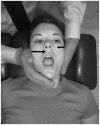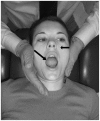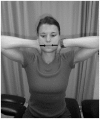Temporomandibular disorders. Part 2: conservative management
- PMID: 24976744
- PMCID: PMC4062348
- DOI: 10.1179/2042618613Y.0000000061
Temporomandibular disorders. Part 2: conservative management
Abstract
Appropriate management of temporomandibular disorders (TMD) requires an understanding of the underlying dysfunction associated with the temporomandibular joint (TMJ) and surrounding structures. A comprehensive examination process, as described in part 1 of this series, can reveal underlying clinical findings that assist in the delivery of comprehensive physical therapy services for patients with TMD. Part 2 of this series focuses on management strategies for TMD. Physical therapy is the preferred conservative management approach for TMD. Physical therapists are professionally well-positioned to step into the void and provide clinical services for patients with TMD. Clinicians should utilize examination findings to design rehabilitation programs that focus on addressing patient-specific impairments. Potentially appropriate plan of care components include joint and soft tissue mobilization, trigger point dry needling, friction massage, therapeutic exercise, patient education, modalities, and outside referral. Management options should address both symptom reduction and oral function. Satisfactory results can often be achieved when management focuses on patient-specific clinical variables.
Keywords: Conservative management; Review; Temporomandibular joint disorders.
Figures












Similar articles
-
Conservative management of temporomandibular dysfunction: A literature review with implications for clinical practice guidelines (Narrative review part 2).J Bodyw Mov Ther. 2017 Jul;21(3):541-548. doi: 10.1016/j.jbmt.2017.05.021. Epub 2017 Jun 1. J Bodyw Mov Ther. 2017. PMID: 28750962 Review.
-
Temporomandibular disorders. Part 1: anatomy and examination/diagnosis.J Man Manip Ther. 2014 Feb;22(1):2-12. doi: 10.1179/2042618613Y.0000000060. J Man Manip Ther. 2014. PMID: 24976743 Free PMC article. Review.
-
Current Trends in the Management of Temporomandibular Joint Dysfunction: A Review.Cureus. 2022 Sep 19;14(9):e29314. doi: 10.7759/cureus.29314. eCollection 2022 Sep. Cureus. 2022. PMID: 36277551 Free PMC article. Review.
-
Reported concepts for the treatment modalities and pain management of temporomandibular disorders.J Headache Pain. 2015;16:106. doi: 10.1186/s10194-015-0586-5. Epub 2015 Dec 7. J Headache Pain. 2015. PMID: 26644030 Free PMC article. Review.
-
Conservative therapy for the treatment of patients with somatic tinnitus attributed to temporomandibular dysfunction: study protocol of a randomised controlled trial.Trials. 2018 Oct 12;19(1):554. doi: 10.1186/s13063-018-2903-1. Trials. 2018. PMID: 30314506 Free PMC article.
Cited by
-
Temporomandibular disorders-related videos on YouTube are unreliable sources of medical information: A cross-sectional analysis of quality and content.Digit Health. 2023 Feb 5;9:20552076231154377. doi: 10.1177/20552076231154377. eCollection 2023 Jan-Dec. Digit Health. 2023. PMID: 36762021 Free PMC article.
-
Evaluation and management of temporomandibular disorders. Part 1: an orthopedic physical therapy update on examination and clinical reasoning.J Man Manip Ther. 2023 Jun;31(3):133-142. doi: 10.1080/10669817.2022.2123171. Epub 2022 Oct 17. J Man Manip Ther. 2023. PMID: 36245265 Free PMC article.
-
Headache and orofacial pain: A traffic-light prognosis-based management approach for the musculoskeletal practice.Front Neurol. 2023 Feb 20;14:1146427. doi: 10.3389/fneur.2023.1146427. eCollection 2023. Front Neurol. 2023. PMID: 36895899 Free PMC article.
-
The Efficiency of Anterior Repositioning Splints in the Management of Pain Related to Temporomandibular Joint Disc Displacement with Reduction.Pain Res Manag. 2018 Feb 21;2018:9089286. doi: 10.1155/2018/9089286. eCollection 2018. Pain Res Manag. 2018. PMID: 29682131 Free PMC article.
-
Clinical Characteristics and Rehabilitation Strategies for the Stomatognathic System Disturbances in Patients with Stroke: A Systematic Review.Int J Environ Res Public Health. 2022 Dec 30;20(1):657. doi: 10.3390/ijerph20010657. Int J Environ Res Public Health. 2022. PMID: 36613028 Free PMC article.
References
-
- Young B, Walker MJ, Strunce J, Boyles R. A combined treatment approach emphasizing impairment-based manual physical therapy for plantar heel pain: a case series. J Orthop Sports Phys Ther. 2004;34:725–33. - PubMed
-
- Furto ES, Cleland JA, Whitman JM, Olson KA. Manual physical therapy interventions and exercise for patients with temporomandibular disorders. Cranio. 2006;24:283–91. - PubMed
-
- Walker MJ, Boyles RE, Young BA, Strunce JB, Garber MB, Whitman JM, et al. The effectiveness of manual physical therapy and exercise for mechanical neck pain: a randomized clinical trial. Spine. 2008;33:2371–8. - PubMed
-
- List T, Axelsson S. Management of TMD: evidence from systematic reviews and meta-analyses. J Oral Rehabil. 2010;37:430–51. - PubMed
Publication types
LinkOut - more resources
Full Text Sources
Other Literature Sources
Medical
